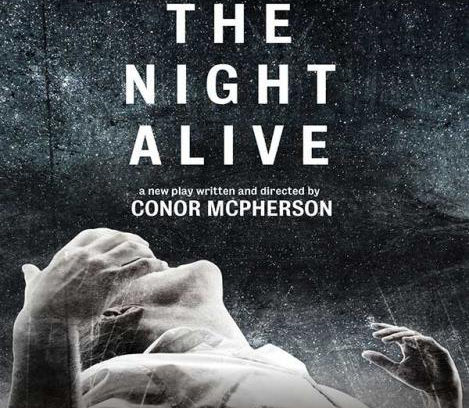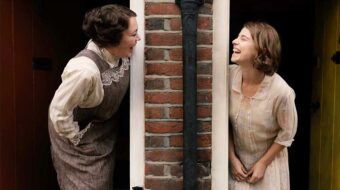
LOS ANGELES – A poster from the 1963 movie The Great Escape is a visual cue that provides a vital clue and key to what’s going on in Irish playwright Conor McPherson’s The Night Alive. This one-acter, enjoying its West Coast premiere at the Geffen Playhouse, is essentially about five Dubliners who live marginal lives. The onstage action takes place in the untidy “apartment” – without so much as a refrigerator – that middle-aged Tommy (Irish-born Paul Vincent O’Connor) rents from an older guardian of sorts named Maurice (Denis Arndt), who insists on calling it a mere “room” in his Edwardian house. Doc (Dan Donohue) is a 30-ish, dimwitted hanger-on and laborer who drifts between sleeping at his sister’s home, Tommy’s place, and a van.
Enter into the pecking order – and into the drab, lonely lives of these three solo men – aimless Aimee (Irish actress Fiona O’Shaughnessy), a 20-something woman with a murky past whom Tommy rides to the rescue of on a white horse, saving this total stranger from a dire predicament. In offering her refuge, he turns the three men’s presumably celibate lives upside down. In the process, Tommy believes he comes alive and is being given a second chance at life.
Although, as said, Alive is a one-act play, what could pass for, more or less, Act I, is quite low key and uneventful – some might even consider it talky and dull. But things really pick up when Kenneth (Irish actor Peter O’Meara, a Trinity College grad who joined the Abbey Theatre Dublin) enters, stage right, from out of nowhere as a kind of bogeyman, turning things topsy-turvy as we learn more about who Aimee really is, and why she needed sanctuary.
This play is essentially about fringe characters yearning to get away from their boring existences. In particular, Tommy is a study in male menopause and mid-life crisis. Separated from his wife and children, somehow eking out a living by tending to “bits and pieces,” residing in Maurice’s room/apartment, he believes Aimee presents him with the opportunity to break free of the mundane, ho-hum routine of his sexless day-to-day monotony. His legs aren’t so much limbs as they are stumps; clearly, this aging, balding man has seen better days. (But maybe not much better.) The details of his and Aimee’s sex life, or what passes for it, are pretty grim – listen closely (there’s a good joke about what causes “repetitive strain injury”). But it’s better than nothing. Doc offhandedly confesses that he’s impotent, while the forlorn Maurice mourns his deceased wife.
Tommy constructs a wild plan to flee Ireland to start anew with Aimee in a place I for one have never before heard referred to as a haven for shattered souls seeking a second lease on life. (Really?) Be that as it may, the aforementioned Great Escape poster tacked to Tommy’s wall is a pop culture reference to the inner meaning of McPherson’s drama.
In that John Sturges World War II classic, Allied POWs plot to escape from a Nazi prison camp. As the “Cooler King,” Steve McQueen (the actor, not the director) nears the border with neutral Switzerland, desperately trying to jump the barbwire fence on a motorcycle in a scene that encompasses humans’ existential struggles for freedom. This sequence is indelibly etched in the mind’s eye of anyone who has ever seen it onscreen, and no one can fail to root for McQueen and his valiant effort to escape from the Nazis to freedom in democratic Switzerland, so near yet so far across the barbed wire.
For Tommy, Aimee is arguably his motorcycle. Will he jump the barbed wire to find freedom?
Alive‘s able, ensemble acting is well directed by Randall Arney, who previously helmed American Buffalo at the Geffen. This seems appropriate, as Alive‘s down-and-out characters brought to mind David Mamet’s 1975 Buffalo characters. (The interactions between Tommy and Doc are also reminiscent of the relationship between George and Lenny in John Steinbeck’s heartbreaking Of Mice and Men.) Takeshi Kata’s set, with its high ceiling, strikes just the right sordid note of dinginess. Daniel Ionazzi’s lighting comes, well, alive in the mystical grand finale.
Peter O’Meara’s Wolfman-like Kenneth puts the “fear” into McPherson’s drama, which takes unexpected turns. O’Shaughnessy, who has played the title role in Oscar Wilde’s Salome at the Gate Theatre Dublin, isn’t particularly sexy as Aimee. But perhaps that’s precisely the point: O’Connor invests Tommy with so much desperation and sexual longing that any female in her twenties seems to have the erotic powers of an Aphrodite.
In 2014, Conor McPherson adapted a new version of The Dance of Death for A Noise Within’s L.A. production of Swedish playwright August Strindberg’s 1900 play. The much-touted and awarded Dublin-born McPherson, who previously wrote The Weir, is in the tradition of those great Gaelic scribes, such as Sean O’Casey and James Joyce, and the Welsh Dylan Thomas. McPherson may perpetuate that image of the Irish as storytellers by making the dopey Doc a writer who scribbles into his notebook. But thankfully, although there is some drinking in Alive, McPherson eschews the stereotype of the Irish as drunks. The Geffen’s production of this 2013 play, with its magical realist, enigmatic ending that had theatergoers scratching their noggins (again, I refer you to the Great Escape poster and another pop cultural signpost, a rendition of Marvin Gaye’s “What’s Going On”), gives Angeleno audiences another opportunity to sample this bard’s vision.
The Night Alive plays through March 15 on Tuesdays through Fridays at 8:00 pm, Saturdays 3:00 pm and 8:00 pm, and Sundays at 2:00 pm and 7:00 pm at the Geffen Playhouse, 10886 Le Conte Ave., L.A. 90024. For info: www.geffenplayhouse.com or (310) 208-5454.

MOST POPULAR TODAY


“Trail of Tears Walk” commemorates Native Americans’ forced removal

Hold the communism, please: SFMOMA’s Diego Rivera exhibit downplays artist’s radical politics

‘Warning! This product supports genocide’: Michigan group aims to educate consumers

After months of denial, U.S. admits to running Ukraine biolabs






Comments